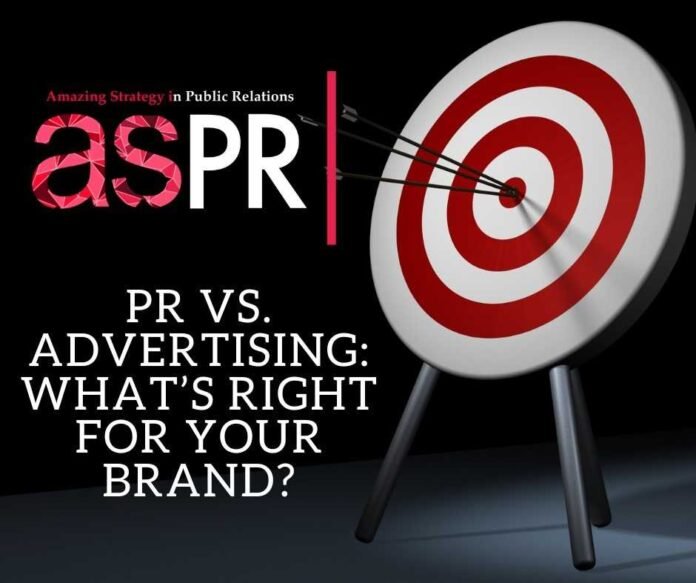When it comes to promoting a brand, two of the most common strategies businesses turn to are Public Relations (PR) and Advertising. Both play significant roles in shaping a brand’s image, attracting attention, and driving business outcomes, but they do so in very different ways. Understanding these differences is crucial to determining which approach is best suited for your brand’s needs.
What is Public Relations (PR)?
PR involves managing a brand’s reputation and fostering relationships with key audiences, including the media, influencers, customers, and investors. It focuses on earned media—coverage that is not directly paid for. PR strategies typically include press releases, media outreach, thought leadership articles, and events that help build credibility and trust for the brand.
Key Elements of PR:
Earned media coverage: Gaining visibility through stories and features in the press, blogs, and other outlets.
Reputation management: Shaping how your brand is perceived by the public.
Relationship building: Creating long-term relationships with journalists, influencers, and other stakeholders.
Thought leadership: Positioning company executives as experts in their field.
What is Advertising?
Advertising, on the other hand, involves paying for space or time to promote a message to a target audience. It’s a controlled message with specific objectives—whether it’s to increase brand awareness, drive sales, or promote a new product. Ads can be placed across various media, including television, radio, print, digital platforms, and social media.
Key Elements of Advertising:
- Paid media: Advertisers pay for ad space or time to have their message seen or heard.
- Direct messaging: Ads are designed with specific calls to action (CTAs), driving immediate results, such as purchases, sign-ups, or inquiries.
- Creative control: Brands have full control over the content and placement of ads, ensuring they are consistent with the brand’s message and objectives.
- Targeted reach: Advertisements can be strategically targeted based on demographic, geographic, and behavioral data.
The Core Differences Between PR and Advertising
Control Over the Message:
PR gives brands less control over the final message. Media outlets, journalists, and influencers interpret and communicate the story, often providing a level of third-party credibility.
Advertising allows full control over the message. Brands dictate the content, tone, and timing of their ads, ensuring consistency across channels.
Cost:
PR is generally less expensive compared to advertising, as it relies on earned media and efforts like media relations, press releases, and events. However, PR also requires consistent effort and investment in relationship building.
Advertising can be more expensive, especially when utilizing premium media channels like TV or digital ads with high impressions. It often requires a budget for creative development, media buying, and analytics.
Credibility and Trust:
PR has the edge when it comes to building trust. Earned media coverage from reputable outlets offers an endorsement of credibility that advertising can’t always provide. Consumers tend to trust media sources more than they trust advertisements.
Advertising is often viewed with more skepticism. While it can be persuasive, audiences know advertisers are paying for the content, which can lead to perceived bias.
Long-Term Impact vs. Short-Term Gains:
PR typically focuses on long-term relationship building and brand reputation. While it may take time to yield results, it can have a lasting impact on how a brand is perceived over time.
Advertising often delivers quicker results, especially when it comes to driving immediate sales or awareness. However, once an ad campaign ends, the impact tends to dissipate unless followed by continued efforts.
Which Is Right for Your Brand?
The answer depends on your brand’s objectives, target audience, and available resources.
Choose PR if:
- You’re looking to build a strong, credible reputation over time.
- You want to earn media coverage and boost your brand’s authority.
- You have a compelling story or thought leader who can speak to industry trends.
- You need to manage your brand’s image in times of crisis or when navigating public perception.
Choose Advertising if:
- You want to drive immediate sales, leads, or conversions.
- You have a clear, targeted audience you want to reach with precision.
- You need full control over your brand messaging and creative.
- You’re launching a new product or service and need a quick impact.
A Combination of Both: The Winning Strategy
In many cases, the best approach is a combination of PR and advertising. Each complements the other—PR can build the credibility that advertising may not achieve on its own, and advertising can amplify PR efforts by reinforcing the message through paid channels. For instance, a successful PR campaign can lead to increased visibility, which can then be supported with a targeted ad campaign to maintain momentum.
Conclusion
Ultimately, the right choice depends on your brand’s goals, stage of development, and the type of relationship you want to establish with your audience. Both PR and advertising offer unique benefits, and when strategically aligned, they can work together to enhance your brand’s overall impact and long-term success.
Written by: Sakshi Singh, CEO & Co-Founder of ASPR Communications


